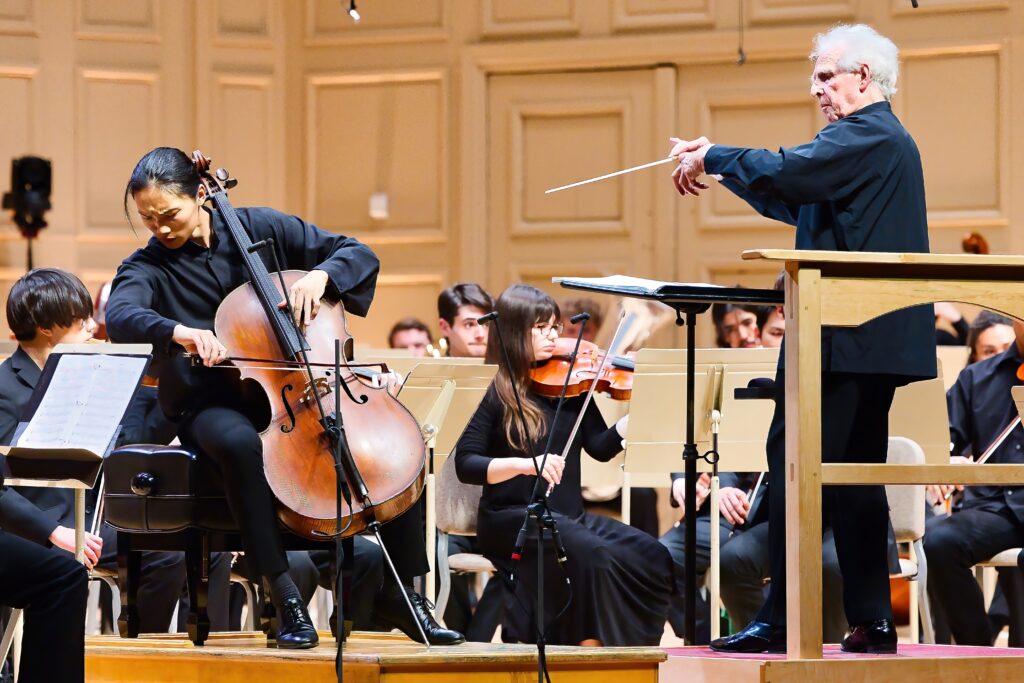Zander, Boston Phil Youth Orchestra wrap season with soulful music

Leland Ko performed Walton’s Cello Concerto with Benjamin Zander and the Boston Philharmonic Youth Orchestra Friday night at Symphony Hall. Photo: Hilary Scott
Composers can’t always be trusted to objectively assess their own works. However, William Walton’s appraisal of his Cello Concerto holds up: “It is to my mind the best of my three concertos,” he wrote to Gregor Piatigorsky, for whom he’d penned the score. “But don’t say so to Jascha,” he added, in reference to Heifetz, who’d received a substantial violin concerto from him some twenty years earlier.
Walton was correct, though contemporary critics were too busy obsessing over passing stylistic fads to recognize the strengths of his effort. Thankfully, though, the music has stood the test of time.
On Thursday, the Concerto returned to Symphony Hall, where Piatigorsky and the Boston Symphony Orchestra gave its premiere in 1957. This time it was assayed by Leland Ko and the Boston Philharmonic Youth Orchestra led by Benjamin Zander.
Zander is a cellist by training and an enthusiasm for the instrument—as well as up-and-coming cellists—is a hallmark of his programming. He worked with Yo-Yo Ma at the start of that superstar’s career and, more recently, collaborated with Zlatomir Fung, who, in 2019, became the youngest winner of the International Tchaikovsky Competition.
Whether or not Ko joins their ranks remains to be seen. But the Juilliard graduate and BPYO alum is an impressive player. On Thursday, he dispatched his part with technical assurance and inviting reverberance: the score’s several stratospheric harmonics each rang with bell-like purity.
Though Walton’s concerto is not the repertoire’s most extroverted vehicle, Ko imbued its handful of brawny episodes—especially the finale’s two unaccompanied “improvisations”—with fire. The central Allegro, with its feisty back-and-forths and brilliant splashes of color, snapped.
In all of this, Ko didn’t eschew the essential poetic aspect of Walton’s writing. That central movement’s bravura passagework, for instance, was ever shapely and the cellist soulfully underlined his recurring lyrical exchanges with the orchestra.
The outer movements’ dreamy turns, too, unfolded with Italianate warmth. In those sections, as well as in his encore of the Largo theme from Dvorak’s “New World“ Symphony, Ko’s double-stopping modeled effortless projection and excellent intonation.
Zander, who noted in his introductory remarks that he was in the audience for the concerto’s British premiere in 1957, drew an accompaniment from the BPYO that knowingly reveled in Walton’s exquisitely colorful orchestration. At times it was perhaps too delicate—the ensemble’s contributions over the first movement’s opening bars bordered on inaudible—but at no point did the collective cover the soloist.
Instead, the partnership highlighted the concerto’s bracing contrasts of character, from its sun-drenched sprays of luminescence to its pages of diaphanous, nocturnal atmosphere. Though tempos sometimes felt a tad expansive, the finale’s closing section was a picture of enchanting tranquility.
Unhurried refulgence also marked the evening’s other big item, Sergei Rachmaninoff’s Symphony No. 2. Completed in 1907, the work’s success secured the composer his place in the symphonic canon, though, from the beginning, its long duration has been a source of grumbling from audiences and musicians alike.
Don’t count Zander and the BPYO among that number, however: Thursday’s uncut account clocked in at just over an hour. If it didn’t rush, neither did it feel unduly distended or indulgent. Rather, there was naturalness to this Second’s pacing that, at least in the moment, suited it well.
Throughout, the performance breathed freely and flexibly, as much in the first movement’s stormy climaxes as in the Adagio’s passionately sculpted phrasings. Balances were smartly managed: the score’s many moving parts—especially the finale’s counterpoint—spoke clearly. Though the second movement’s fugue threatened to derail once or twice and fatigue set in a bit near the end, the sheer brio, warmth, and responsiveness of the BPYO’s performance carried the day.
The last two qualities also applied to the concert’s opener, Debussy’s Prelude to the Afternoon of a Faun. In more than a few regards, this interpretation—plush, languorous, and texturally lucid—anticipated both the Rachmaninoff and Walton selections. Ensemble solos, highlighted by turns from principal flute Sadie Goodman and concertmaster Michael Fisher, were of the highest order.
As is the convention with the final BPYO concert of each season, the orchestra closed the night by saying farewell to departing members with “Nimrod” from Elgar’s Enigma Variations. Turnover in youth orchestras is, of course, commonplace. But one of the ensemble’s conspicuous strengths in recent years has been its core of players who have been together since the end of the pandemic, if not before.
With those numbers now splintering, Thursday’s “Nimrod” took on a poignant air. But it wasn’t one of despair. As Zander likes to point out, this is music about love and friendship, not death. Also, the hope of regeneration: as the conductor promised before leading the late-night grand finale (the house lights finally went up just before 11), “We’ll be back next year.”
Posted in Performances